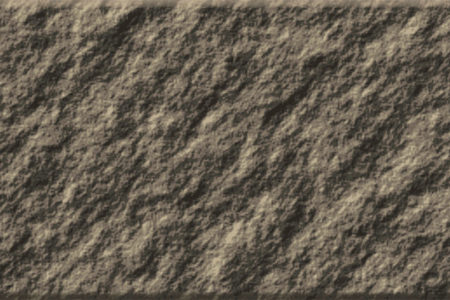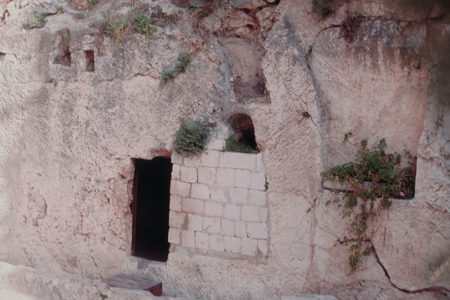Art Thou He That Should Come?
The “waiting ones,” a small group of people in a tiny and oppressed nation, watched for Him. For 1,500 years, others like them had waited for a coming Deliverer; yet He had not come. One of those waiting at the Temple had been promised by God “that he should not see death, before he had seen the Lord’s Christ [Messiah]” (Lk 2:26). Taking the small infant in his arms, old Simeon prayed, “Lord, now lettest thou thy servant depart in peace, . . . For mine eyes have seen thy salvation” (Lk. 2:29–30).
Another, a widow of great age, after seeing the Child, “spoke of him to all those who looked for redemption” (Lk. 2:38). Not all who were waiting, however, were old. In the nearby Migdal Eder, where He was to be revealed, lay flocks of sacrificial Temple sheep tended by shepherds who could not avoid thinking of His coming. And not all of these “waiting ones” were Jewish, for Gentiles—wise men from the East—followed the sign of the Jewish King-Messiah to the tiny child in Bethlehem.
Thirty years later, John the Baptist waited. For him it was a matter of life and death. He was captive in a Roman jail, just as his nation of Israel was captive to Roman domination. He, along with many others, looked for national deliverance such as the nation had experienced through Moses. Seeking assurance, John and his disciples asked Jesus of Nazareth, “Art thou he that should come, or do we look for another?” (Mt. 11:3).
Even today, Rabbi Hayim Halevy Donin looks for a coming Messiah who will “bring about the political and spiritual redemption of the people Israel through the ingathering of the Jews to their ancestral home of Eretz Yisrael and the restoration of Jerusalem to its spiritual glory.” Unlike “the waiting ones” who wait no more, he, along with many others, still awaits the one who will accomplish “what the Messiah was supposed to accomplish.” Yet more than 456 specific Old Testament Messianic prophecies tell us how to recognize the Messiah and show us if He has come or if “we look for another.”
Ancestry of the Coming Messiah
Ancient Jewish writings derive the Messiah’s ancestry (a son of the sons of Jesse) from Isaiah’s prophecy: “And there shall come forth a rod [twig] out of the stem [stump] of Jesse, and a Branch shall grow out of his roots” (Isa. 11:1). Isaiah wrote this section during a very difficult period in Israel’s history (739 B.C. to approximately 692 B.C.). By 701 B.C., the Assyrian army under Sennacherib already had conquered the northern kingdom and was threatening the southern kingdom. Isaiah likened God’s miraculous destruction of the Assyrian army (Isa. 10:33–34) to a man hewing down a mighty tree with an ax (2 Ki. 19:35–37; 2 Chr. 32:21; Isa. 37:36–38). This event prefigures Israel’s ultimate deliverance from all its enemies by the “ax” of the Messiah against the strong “tree” of Israel’s foes.
Surprisingly, Isaiah links the Messiah’s ancestry to Jesse rather than to King David or Nahshon, chief of the tribe of Judah during Moses’ day. In Isaiah’s day, Nahshon’s once-noble line had become a mere tree stem, or stump. David’s enemies often insulted him by calling him the “son of Jesse” rather than “son of Nahshon” (1 Sam. 20:27, 30; 22:7; 25:10; 2 Sam. 20:1). Since many expected the Messiah to come from a leading or wealthy family or from a powerful leader, they would have been shocked to think of Messiah as a “rod” of humble ancestry. Yet from the insignificant “root” of Jesse would come the mighty Messiah-Deliverer.
On his deathbed, the great patriarch Jacob prophesied of this “rod” and the “last days” (Gen. 49:1). Blessing his son Judah, Jacob declared,
The scepter shall not depart from Judah, nor a lawgiver from between his feet, until Shiloh come; and unto him shall the gathering of the people be (Gen. 49:10).
This early Messianic prophecy declared the ruling authority (“the scepter”) of the last days to be Shiloh. Scholars interpret Shiloh many ways, but the best meaning seems to be “rest giver.” This rest includes the reunification of Judah and Israel and an end to their enemies:
There shall come a Star out of Jacob, and a Scepter shall rise out of Israel, and shall smite the corners of Moab, and destroy all the children of Sheth” (Num. 24:17).
These are just a sample of the many prophecies indicating that the Messiah will be the preeminent King of a united Israel in the last days. Then He will bring peace and rest to all under His rule. In addition to the Old Testament prophecies, more than 558 rabbinic writings interpreted the Scriptures as proclaiming a future earthly Kingdom ruled by the Messiah. “Art thou he that should come?” (Mt. 11:3). Jesus of Nazareth’s ancestry, recorded in Matthew 1, answers a resounding yes.
Acts of the Coming Messiah
A second way to authenticate the real Messiah involves examining His actions. Did Jesus do what Messiah was supposed to do? When asked, “Art thou the One?” Jesus answered,
The blind receive their sight, and the lame walk, the lepers are cleansed, and the deaf hear, the dead are raised up, and the poor have the gospel preached to them (Mt. 11:5).
Physical healing served as undeniable, visible evidence of Jesus’ Messiahship. Anyone restoring sight, healing the lame, cleansing the leper, restoring hearing, and even raising the dead must be doing the miracles of the Messiah. Since all of these physical ills entered the world because of man’s fall in the Garden of Eden, such signs pointed to a spiritual restoration offsetting the curse of sin.
Therefore, these miracles prefigure the restoration of all the redeemed in Messiah’s coming Kingdom of Peace, where the blind shall see and deaf shall hear. There the lame shall leap as harts, and the dumb shall sing (Isa. 35:5–6). Thus the rest giver’s acts of physical restoration help us picture spiritual restoration (Isa. 35:4).
However, Messiah’s prime authenticating sign was His ability to draw people as an “ensign” to Him for spiritual healing: “In that day there shall be a root of Jesse, who shall stand for an ensign of the peoples” (Isa. 11:10). In the ancient world, an ensign (or flag) on a tall pole was where troops rallied around their general. Moses used the bronze serpent as an ensign to offer healing in the wilderness (Num. 21:8–9). Jesus referred to that ensign as a sign of the spiritual healing He offered (Jn. 12:32). Unlike the mere root of a tree, Messiah would raise David’s line to prominence as the tall ensign, drawing men to Him and offering spiritual salvation to all those seeking Him. Isaiah testified, “Behold, God is my salvation; I will trust, and not be afraid” (Isa. 12:2).
Does Isaiah 12:2, then, mean the Messiah will be God? In chapter 9, the book of Isaiah answers that question with an explicit yes:
For unto us a child is born, unto us a son is given, and the government shall be upon his shoulder; and his name shall be called Wonderful, Counselor, The Mighty God, The Everlasting Father, The Prince of Peace. Of the increase of his government and peace there shall be no end, upon the throne of David, and upon his kingdom, to order it, and to establish it with justice and with righteousness from henceforth even forever (vv. 9:6–7).
“Wonderful” speaks of things that are unusual and beyond human capabilities. Thus the “Wonderful” one would perform miracles that defied explanation apart from God. Further, in the Old Testament, the term Wonderful is applied exclusively to God. Since Jesus performed such signs, He is “Wonderful” and must be God.
Twice more Isaiah emphasized that Messiah would be God by proclaiming Him “The Mighty God, The Everlasting Father.” This statement answers both how and why the Messiah could perform miracles, for they demonstrate that God Himself is the Messiah. Further, only God can bring the gospel of salvation to the poor and give real peace, for He is the “Prince of Peace,” the “rest giver” of Shiloh.
Paul told us that the Jewish people of his day sought signs or miracles in order to recognize the Messiah, the King of Israel, the Son of Jesse and David, and God Himself. Thus Jesus offered signs as an ensign to all men who would seek Him. “Art Thou he that should come?” Jesus of Nazareth answered a resounding yes by His wondrous acts 2,000 years ago.
Appeal of the Coming Messiah
Many of the Messianic prophecies associate the Messiah with events of the latter days when the Messiah will call the Jewish people back to their land. Since 1948, God has been gathering “the dispersed of Judah from the four corners of the earth” (Isa. 11:12). But simultaneous to this gathering, the world is gathering against the little nation of Israel. Scripture tells us that Israel will be surrounded by its foes in the latter days, and only those who love Israel and God will desire Israel’s triumph:
Behold, I will make Jerusalem a cup of trembling unto all the peoples round about, when they shall be in the siege both against Judah and against Jerusalem. And in that day will I make Jerusalem a burdensome stone for all peoples. And I will pour upon the house of David, and upon the inhabitants of Jerusalem, the Spirit of grace and of supplications; and they shall look upon me [the Messiah] whom they have pierced, and they shall mourn for him, as one mourneth for his only son (Zech. 12:2–3, 10).
In that day, “the LORD shall be king over all the earth; in that day shall there be one LORD, and his name one” (Zech. 14:9).
Whether you are Jewish or Gentile, the Messiah is appealing to you now. He is “an ensign of the peoples; to him shall the nations seek, and his rest shall be glorious” (Isa. 11:10). Today both Jewish and Gentile people find “glorious” rest in the “rest giver” through personal salvation in Jesus the Messiah.
Almost 2,000 years ago, Jesse’s descendant Jesus of Nazareth, after performing many Messianic signs, returned to a city and “the people gladly received him; for they were all waiting for him” (Lk. 8:40). Are you still waiting for Him? Have you answered the question, “Art thou he that should come, or do we look for another?” Look no further, for Jesus of Nazareth is truly God, truly Messiah, and truly the Lord and Savior. “And it shall come to pass that whosoever shall call on the name of the LORD shall be delivered” (Joel 2:32).






